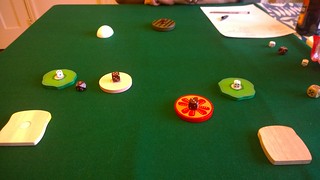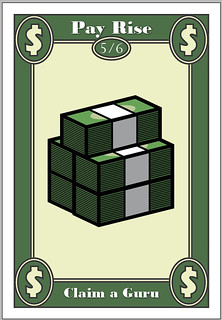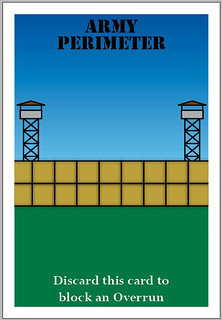After reading
very positive reviews on BGG and getting agreement on Twitter I bought the Kobold Guide to Games Design by Mike Selinker. It's a series of essays by gaming giants (Richard Garfield, Steve Jackson, Dale Yu, Rob Daviau, Andrew Looney and several more I'd never heard of, but should have!). I've only just started it, but already I've coming across an essay by Jeff Tidball (designer of
Pieces of Eight) about how games should be formed in three acts, like a story, book or film.
Jeff's conceit is that the three stages of a game correspond to:
- Setting the stage: The first act sets the boundaries of the conflict, allowing players to work out how and where to focus their efforts,
- The meat of the gameplay: The players will be competing trying to get into position for a push for victory,
- The push for victory: The player's will be attempting to strike for a game win, or stop others doing the same.
It struck me while reading the essay that that description neatly fits the way a game of Zombology plays out, despite the fact it only lasts ten minutes!
The first act is the first couple of hands - you're playing the game blind at this point - you've no idea which therapies the players are supporting, or even which ones could possibly lead to a victory. At this point you have a crazy optimism of a crackpot scientist who believes it is possible to cure the Zombie Plague with Homeopathy, or A Nice Cup of Tea. With everyone in the same position, it feels like a co-operative game - we
can do this!
We can cure the plague.
This phase can last a different length of time for different players - in a game with fewer players someone might start with the Cure for Healing Crystals, and hence know this is a good therapy to back, while others might not see a high valued card for several rounds.
As new and better cards come into the draft you start to build an understanding of what is possible in this game - which suits are being backed and, as you start to see the 4s, 5s and 6s going round, which suits have the potential to lead to a victory. In the next five or six rounds the battle lines are drawn. It's very unlikely that you can win the game as the only player to have played the winning therapy - you have to work together to get the evidence required to cure the Zombie Plague. As the game develops you start to see teams forming, as two or more players back one therapy while others back different therapies. Some therapies may not have been backed at all, or only by a single player - these will wither and die as the players focus on the therapies most likely to effect a cure.
You now have shifting alliances - it has morphed into a team game (where the teams are changing as people get into therapies that have potential). Players will work together to help a cure they can win in, or fight tooth and nail to scotch a cure that will lose them the game. Players will be keeping track of who has the Cures they've seen and whether a player is likely to play one this turn. If so, can they share that victory? Or do they need to try and stop it?
As the game nears the eighth round and the prospect of total annihilation of humanity looms the pressure builds - is it possible to cure the plague? Can you win, or must you doom seven billion souls to save face?
The final act is the when a player has the Cure in hand and is in a position to play it and win. They may have already done what they can to protect themselves from another player's spoiling, or they may be relying on others to help protect them for the shared victory. Others might be trying to stop them, ride on their coattails to victory or trying to see if there's a double (or triple) Cure that they can back sufficiently to also share in the success. The player with the Cure is excited - can the card be successfully played? Is there too much risk (you might know who has the ability to stop you with a well-timed zombie attack)? Could you even feint and play a different card, trying to draw out the attacks early while passing the Cure to the next player who would also play it?
The three acts analogy is an interesting lens to view a game through, and I'll definitely be considering it when I return to working on Vacuum.








